Last Updated on January 23, 2024
Our visit to the Killing Fields starts with…
Bargaining for a ride to slaughter.
The strangest part about a visit to the Killing Fields takes place right at the start. As you do in most South East Asian cities, the day begins by bargaining with a tuk-tuk driver over the price of a day tour. Except today we are making this driver take us out to visit sites where thousands of people were tortured and murdered.
For the driver, today is just like any other day, and we are just two more tourists who he’ll drive first to visit the Killing Fields, where over 20,000 Cambodians were brutally murdered and buried in shallow mass graves from 1976-1979. Then the tuk-tuk will sputter over to Tuol Sleng, or S-21, the school which was turned into a prison where those same Cambodians were imprisoned and brutally tortured for days, weeks, months at a time before being transported to the Killing Fields. At the end of this day, he says will also bring us to the Russian Market, a fairly large market area with tourist trinkets, which seems fine at the time.
So how much are we supposed to pay for this? At first he wants $20…but we have been in Cambodia for a few weeks now and know that is far too high. Without much effort, we get him down to $10. While we don’t exactly feel comfortable bargaining down, what comes next truly disturbs us. In order to make an extra $5 our driver attempts to offer an extra element to the day: he wants us to start off the day with a visit to a shooting range.
Do we want to go to a shooting range?
Apparently, the shooting range is one of the ten or so main options offered by all tuk-tuk drivers in Phnom Penh. We are about to go learn about the mass murder of over two million innocent Cambodians. We have a heavy feeling of dread, fear, and sadness about what we are about to go do, and we haven’t even gotten there yet. What kind of person would want to shoot things up after a day like we were about to have (it turns out, plenty of people do).
We politely and incredulously decline, and off we go to the Killing Fields. Roughly 45 years old, the driver would have been a child during the time the Khmer Rouge were in power. He has most likely lost dozens of family members and friends, and now spends every day taking tourists out to where some of the most heinous crimes were committed. Needless to say, we definitely feel uncomfortable thinking about that for too long.
Humbling moments at the Killing Fields
We are not the first to arrive here, and at first I cringe at the bus loads of well-fed tourists mulling about with their headsets on. They are listening to an audio-tour, no different than a day out at an art museum and the contrast to the starvation and suffering on these grounds 30 years ago was too much to handle for me. But within a few minutes of listening in, I realize how important it is for people to come here and learn about the genocide unleashed on Cambodia by Pol Pot and the Khmer Rouge.
In school, we learn about Nazi Germany under the pretext that genocide must never happen again, yet no mention was made of Cambodia, where the Khmer Rouge killed anyone who was educated or spoke foreign languages, while others were forced to work in labor camps. Over 25% of the population, or 2 million people, were killed from 1975-1979, in order to create the all-agrarian society Pol Pot believed was necessary in order to free Cambodia and make it independent of outside influence.
There are moments here that I will never forget.
Visualizing how the ground bubbled up as gasses from the 20,000 buried bodies were released. Seeing the clothes that had rotted off the victims still scattered on the ground, partially exposed by wind and rain. Standing in front of the Killing Tree, against which Khmer Rouge soldiers bashed babies and their mothers like sacks of potatoes until they died; the price of bullets too precious to waste.
Stop 18, the last stop on the walking tour, brings you to the massive pagoda, the center point of what is now a memorial park. Over 9,000 skulls are piled inside this 17-storey structure, along with bones and more piles of clothing. Witnessing this makes the scale of the killing truly tangible. As at other points of the tour, I am immediately sick; nausea mixes with a piercing pain in my temples and an angry fire in my heart and my stomach too hard to explain.
If you want to visit the Killing Fields (and you should!), be aware that this is a very sobering and unsettling experience that will stick with you for a long time.
Chances of survival slim to none
We learn at our next stop, the Tuol Sleng Genocide Museum, that of the 20,000 people who were tortured at this former prison, only seven people survived. Around the country there was a much higher rate of survival, but here at S-21, just stepping through the doors meant sentencing to months of torture before eventual death.
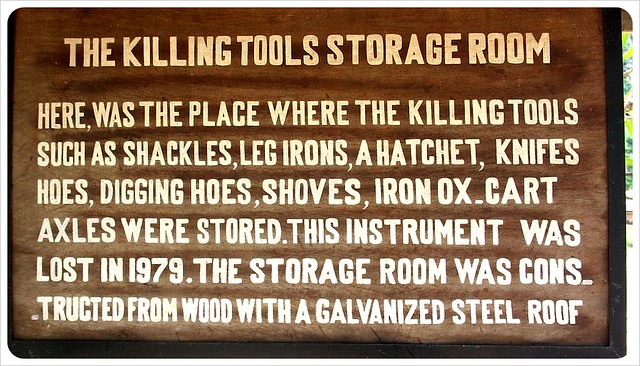 Before we stepped through the doors, however, we were confronted by a legless blind man begging for money outside. I decide he is, no doubt, a victim of the regime, who now spends his days outside one of the darkest locations in Cambodia’s history.
Before we stepped through the doors, however, we were confronted by a legless blind man begging for money outside. I decide he is, no doubt, a victim of the regime, who now spends his days outside one of the darkest locations in Cambodia’s history.
Passing through the doors, thousands of fearful eyes stare back at us, in the form of black and white photographs. Head shots of every single man, woman and child brought to this detention center were taken, methodically documented their arrival. I stare at photograph after photograph choking back tears, knowing that if I let one fall, I won’t be able to stop.
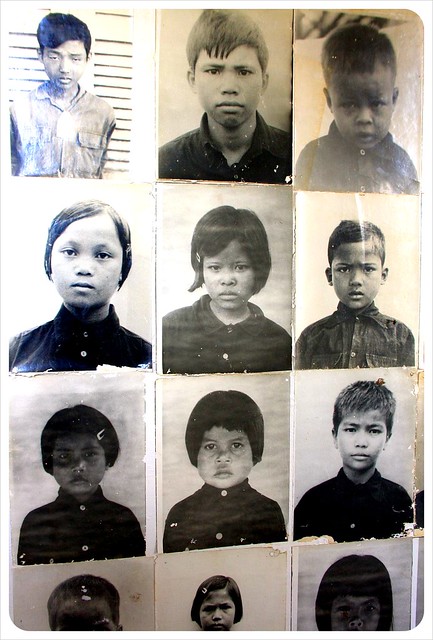 The hardest moment came at the end, when we were just about to leave. One of the seven survivors was sitting at a table in front of the prison, signing copies of his tale of survival. There was a part in both of us that wanted to run to him, grab his hand, cry with him, buy his book, but something held us both back. The thought of returning, every day, to the place where I was hung from poles by my ankles, with my face hanging in a bucket of water (or worse), electrocuted, cut, beaten and forced to live on rice water for months at a time…this was too shocking.
The hardest moment came at the end, when we were just about to leave. One of the seven survivors was sitting at a table in front of the prison, signing copies of his tale of survival. There was a part in both of us that wanted to run to him, grab his hand, cry with him, buy his book, but something held us both back. The thought of returning, every day, to the place where I was hung from poles by my ankles, with my face hanging in a bucket of water (or worse), electrocuted, cut, beaten and forced to live on rice water for months at a time…this was too shocking.
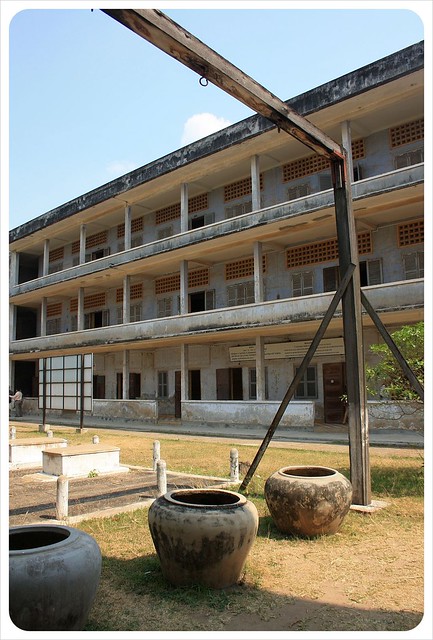 We walk out with the heaviest of hearts, and limply agree to stop at the Russian Market as planned, though at this point I may have paid him double just to go back to the hotel. We wander through the tourist trinkets and buy a coconut, but don’t last more than twenty minutes at the market. A thought hits me on the ride back…maybe my tuk-tuk driver wasn’t a victim…what if he was a child soldier? What if that beggar out in front of S-21 was, too? In fact, how many people in the Russian Market, selling t-shirts, headphones or perfumes were Khmer Rouge soldiers and how many were victims?
We walk out with the heaviest of hearts, and limply agree to stop at the Russian Market as planned, though at this point I may have paid him double just to go back to the hotel. We wander through the tourist trinkets and buy a coconut, but don’t last more than twenty minutes at the market. A thought hits me on the ride back…maybe my tuk-tuk driver wasn’t a victim…what if he was a child soldier? What if that beggar out in front of S-21 was, too? In fact, how many people in the Russian Market, selling t-shirts, headphones or perfumes were Khmer Rouge soldiers and how many were victims?
Anyone between the age of 40-60 must have been involved one way or the other. There has been hardly any accountability for what happened in the years from 1975-1979. So little, in fact, that Pol Pot himself died safely and peacefully in exile in Thailand in 1998, never brought to trial for his sins. And even now, the UN tribunal trying the highest Khmer Rouge leaders is still making headlines.
Learn more about Cambodia’s history
If you are interested in finding out more about the Khmer Rouge, please read First They Killed My Father, the autobiography of Luong Ung, a Cambodian woman who was just five years old when her family and thousands of others were evacuated from Phnom Penh in 1975. Her incredible story of survival takes you on her journey, from near starvation in a labor camp to becoming an orphan to time as a child soldier and on to her new life in the United States. Her second book, Lucky Child, tells the heartwarming story of the family’s reunion in Cambodia, a country that continues to heal.
How to get to Phnom Penh
You can travel to Phnom Penh from Thailand by bus (about 12 hours from Bangkok) or take a cheap flight from Bangkok. If you are coming from Siem Reap, you can either fly or take a bus (5 – 6 hours).
How to visit the Killing Fields
Any tuktuk driver in Phnom Penh will be happy to drive you to the Killing Fields. Be smart and negotiate the fare before you get in.
.

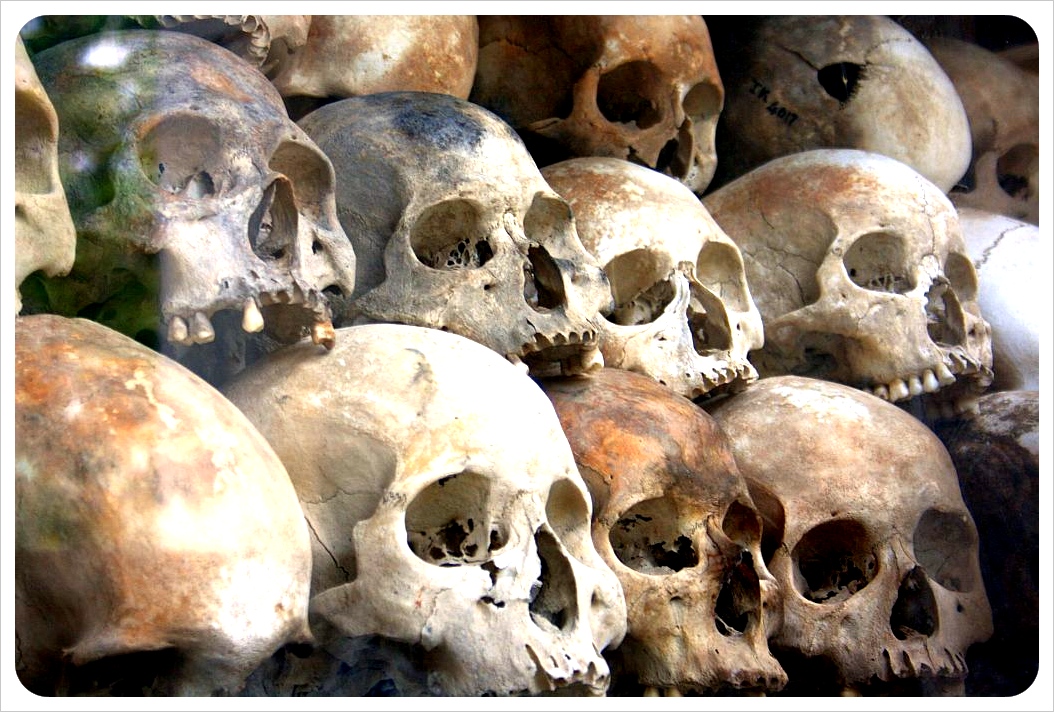
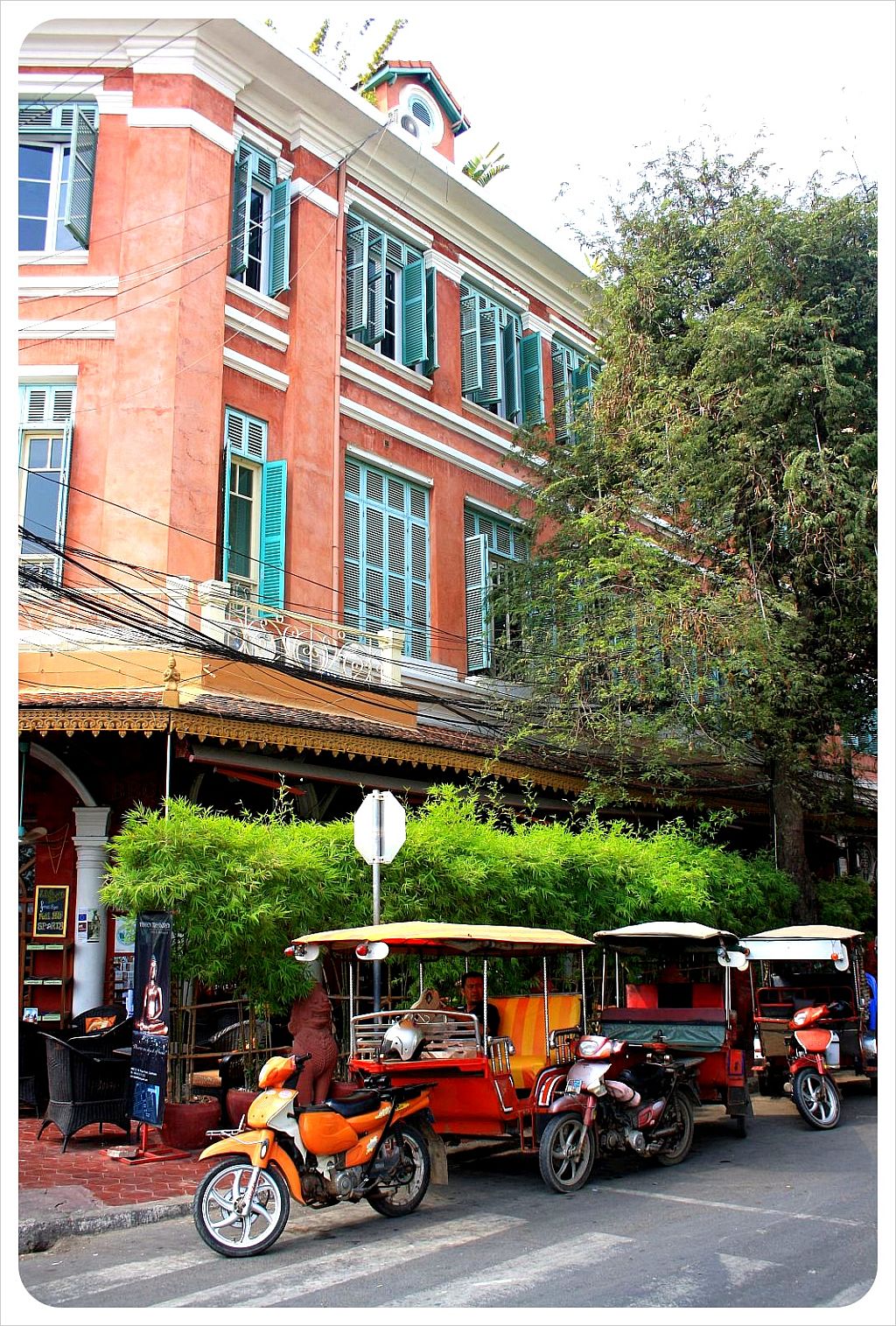

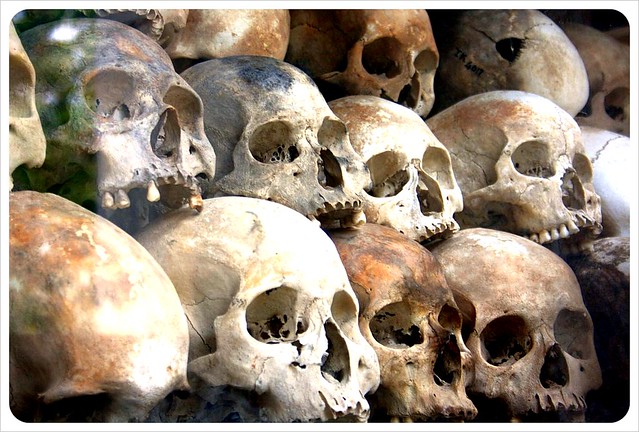
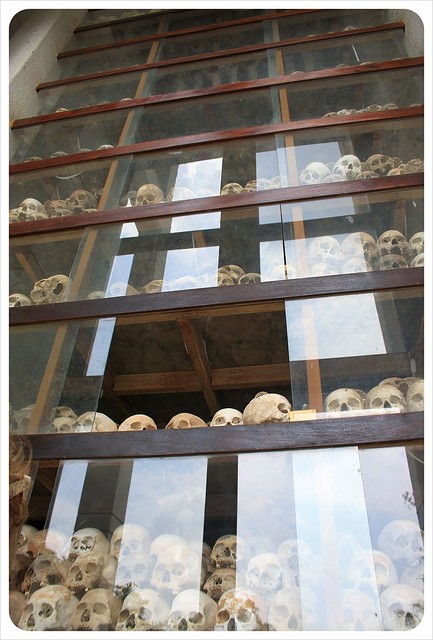
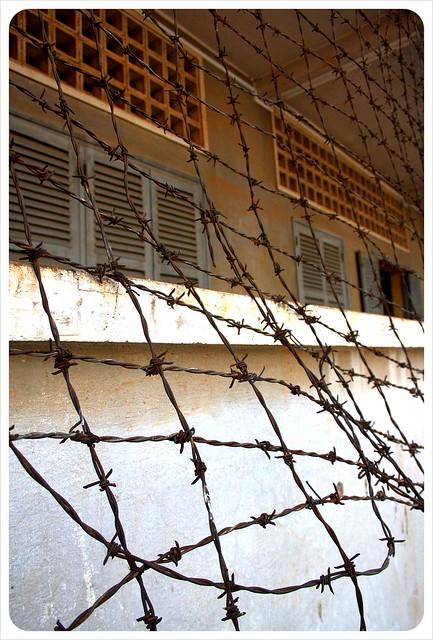


Mary - Green Global Travel
Thursday 9th of August 2012
I share your feelings of being torn when seeing the well fed tourists. However, like you, I'm glad they are there to see the horrors that have occurred in our lifetimes. It's important for all of us to see what people and governments are capable of.
Dani
Sunday 12th of August 2012
You are absolutely right, Mary - it is good to see that people learn about these horrible things that are not very well known in the rest of the world. When we arrived in Cambodia we only knew roughly what had happened under the Khmer Rouge, but we learned so much more when we traveled through the country and visited all these places like the Killing Fields, Killing Caves and the Tuol Sleng prison.
Amanda
Friday 6th of July 2012
I agree that this is something we don't learn enough about in Western countries. In fact, many people I've talked to have never even HEARD of the killing fields. I can't imagine how hard it must be to visit, knowing a bit about it. I probably would have been bawling my eyes out.
Jess
Friday 6th of July 2012
Thanks Amanda, so glad you agree. It's one of those things where we are so glad to travel to learn all of this but it was so heartbreaking to actually experience.
The Best Travel Blogs and Posts in June | The HostelBookers Blog
Monday 2nd of July 2012
[...] too, but it’s weird, don’t you think? The Globetrotter Girls wrestle with this is Bargaining for a Tour of Murder in Cambodia - a review of the famous Killing [...]
Jade Johnston - OurOyster.com
Tuesday 26th of June 2012
I found tuel slung so upsetting, but I didn't visit the killing fields. There are so many first person accounts written in books that you can buy there, and some of them made me really emotional... what an aweful history.
Mary
Friday 22nd of June 2012
Great write up! I plan to go next week with my 13 year old son. We know what to expect but also know emotion may over come us. I think getting to know these kind and wonderfully resilient people already will make it that much harder to know what they have endured.
I am reading Pol Pot right now and it is totally fascinating and sickening. The history of Cambodia both before him and after him were also quite painful to read. The US involvement in it all makes me feel embarrassed to my core!